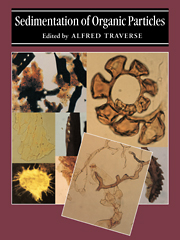Book contents
- Frontmatter
- Contents
- Editor's preface
- List of contributors
- I Introduction
- II Studies of palynosedimentation in modern environments
- 2 The sorting of spores and pollen by water: experimental and field evidence
- 3 Transport and deposition of pollen in an estuary: signature of the landscape
- 4 Pollen preservation in alkaline soils of the American Southwest
- 5 Wind and water transport and sedimentation of miospores along two rivers subject to major floods and entering the Mediterranean Sea at Calvi (Corsica, France)
- 6 Sedimentation of land-derived palynomorphs in the Trinity–Galveston Bay area, Texas
- 7 The genesis and sedimentation of phytoclasts with examples from coastal environments
- 8 Palynofacies of some recent marine sediments: the role of transportation
- 9 Maceral palynofacies of the Louisiana deltaic plain in terms of organic constituents and hydrocarbon potential
- 10 Organic sedimentation in a carbonate region
- 11 An approach to a standard terminology for palynodebris
- 12 Relationships of palynofacies to coal-depositional environments in the upper Paleocene of the Gulf Coast Basin, Texas, and the Powder River Basin, Montana and Wyoming
- III Reconstruction of late Cenozoic vegetation and sedimentary environments from palynological data
- IV Application of data on palynosedimentation to solution of geological problems
- V Appendix
- Index
12 - Relationships of palynofacies to coal-depositional environments in the upper Paleocene of the Gulf Coast Basin, Texas, and the Powder River Basin, Montana and Wyoming
Published online by Cambridge University Press: 06 January 2010
- Frontmatter
- Contents
- Editor's preface
- List of contributors
- I Introduction
- II Studies of palynosedimentation in modern environments
- 2 The sorting of spores and pollen by water: experimental and field evidence
- 3 Transport and deposition of pollen in an estuary: signature of the landscape
- 4 Pollen preservation in alkaline soils of the American Southwest
- 5 Wind and water transport and sedimentation of miospores along two rivers subject to major floods and entering the Mediterranean Sea at Calvi (Corsica, France)
- 6 Sedimentation of land-derived palynomorphs in the Trinity–Galveston Bay area, Texas
- 7 The genesis and sedimentation of phytoclasts with examples from coastal environments
- 8 Palynofacies of some recent marine sediments: the role of transportation
- 9 Maceral palynofacies of the Louisiana deltaic plain in terms of organic constituents and hydrocarbon potential
- 10 Organic sedimentation in a carbonate region
- 11 An approach to a standard terminology for palynodebris
- 12 Relationships of palynofacies to coal-depositional environments in the upper Paleocene of the Gulf Coast Basin, Texas, and the Powder River Basin, Montana and Wyoming
- III Reconstruction of late Cenozoic vegetation and sedimentary environments from palynological data
- IV Application of data on palynosedimentation to solution of geological problems
- V Appendix
- Index
Summary
Introduction
Research by Fisher and McGowen (1967) on the stratigraphy and sedimentology of the upper Paleocene part of the Wilcox Group in the Gulf Coast Basin in Texas (Fig. 12.1C) resulted in the definition of seven ancient depositional systems in the outcropping and subsurface Wilcox. Coal-forming peat had accumulated within four of them. Traverse and Nichols (1967), Nichols (1970), and Nichols and Traverse (1971) identified paleoecologically significant groups of palynomorphs within assemblages from outcropping Wilcox coal beds in an effort to distinguish palynologically the interrelated but differing depositional systems defined by Fisher and McGowen.
In the Powder River Basin of Montana and Wyoming (Fig. 12.IB), studies on lower Tertiary coal deposits of the Fort Union Formation by Flores (1981,1983), Flores and Hanley (1984), and Hanley and Flores (1987) provided a similar stratigraphic and sedimentologic framework for palynological studies. Depositional models for coal formation in this region were proposed by Pocknall (1986a) and Pocknall and Flores (1987); see also Satchell (1984; 1985). As in the Gulf Coast study, an aspect of research on Powder River Basin coal beds was the identification of groups of palynomorphs that represent the depositional environments.
In this chapter we expand upon the interpretations of Nichols and Traverse (1971) for upper Paleocene coal beds of the Gulf Coast Basin and compare them with those obtained by Pocknall and Flores (1987) for upper Paleocene coal beds in the Powder River Basin. We use palynofacies to characterize and contrast coal-depositional environments within these regions.
- Type
- Chapter
- Information
- Sedimentation of Organic Particles , pp. 217 - 238Publisher: Cambridge University PressPrint publication year: 1994
- 6
- Cited by



